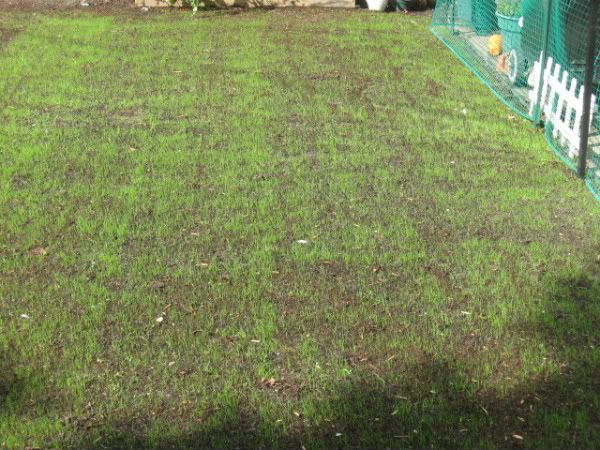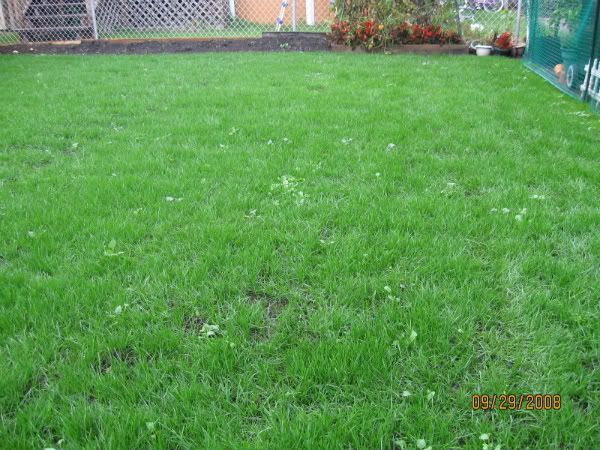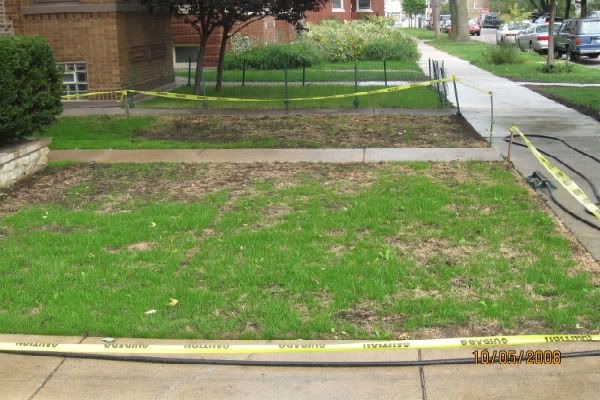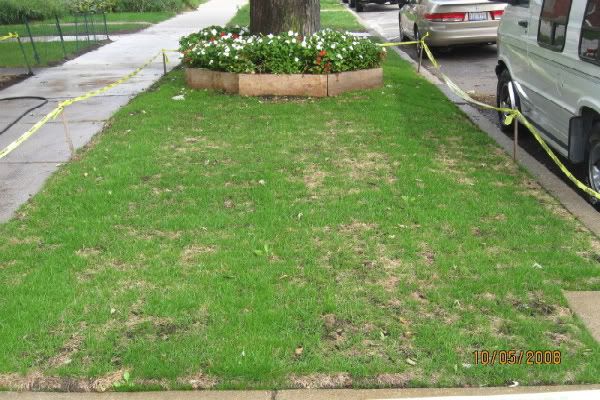Longer Article on Soil Management
- andy10917
- Posts: 29741
- Joined: February 23rd, 2009, 10:48 pm
- Location: NY (Lower Hudson Valley)
- Grass Type: Emblem KBG (Front); Blueberry KBG Monostand (Back)
- Lawn Size: 1 acre-2 acre
- Level: Advanced
Longer Article on Soil Management
I'm going to be writing a longer Article on Soil Management for the BESTLAWN INFO Articles area. Actually, it will be three articles - one for the New or Casual Lawn Owner that covers the basics of soil testing, the interpretation of results and soil amending; one for the Experienced Lawn Owner that wants to venture beyond the basics; and one for people that want to get into advanced topics.
I'd like to hear ideas from BESTLAWN INFO users about what they'd like to be able to get from the article(s) and which of the Basic/Intermediate/Advanced versions you feel would best match your experience level.
Thanks all !!!
Update: The article is now available here
I'd like to hear ideas from BESTLAWN INFO users about what they'd like to be able to get from the article(s) and which of the Basic/Intermediate/Advanced versions you feel would best match your experience level.
Thanks all !!!
Update: The article is now available here
-
GaryCinChicago
- Posts: 6332
- Joined: January 31st, 2009, 10:04 pm
- Location: Chicago, IL.
- Grass Type: KBG
- Lawn Size: Not Specified
- Level: Not Specified
Re: Longer Article on Soil Management
Perhaps useful for those who are thinking of a late season 2009 renovation, the process of building and maintaining the soil's foundation during spring and summer, prior to sowing seeds.andy10917 wrote:
I'd like to hear ideas from BESTLAWN INFO users about what they'd like to be able to get from the article(s)
- Dchall_San_Antonio
- Posts: 3343
- Joined: December 17th, 2008, 1:53 am
- Location: San Antonio, Texas
- Grass Type: St Augustine
- Lawn Size: 5000-10000
- Level: Advanced
Re: Longer Article on Soil Management
I would like to see your thoughts on this article written in 1900.
Okay, so it's written in Russian . Go to Google and use their language tools to translate the entire website at once. You will have to refresh your screen many times. Each time you refresh the screen more of the article gets translated. Apparently Google does have a limit on character count or something because at about chapter 11 it stops translating. And according to Valerie_RU at GW, some of the language in the booklet has been abandoned in Russia and the translators do not work quite right. Use your imagination or write to Valerie and he will be happy to help you. He loves it when we take an interest in his country's scientific achievements.
. Go to Google and use their language tools to translate the entire website at once. You will have to refresh your screen many times. Each time you refresh the screen more of the article gets translated. Apparently Google does have a limit on character count or something because at about chapter 11 it stops translating. And according to Valerie_RU at GW, some of the language in the booklet has been abandoned in Russia and the translators do not work quite right. Use your imagination or write to Valerie and he will be happy to help you. He loves it when we take an interest in his country's scientific achievements.
I am fascinated by the discussion about humus (compost). For example Ovinski says that humus absorbs ammonia gas from the atmosphere and holds it. It also absorbs moisture and when the temperature drops to the dew point, the ammoniated dew drips down into the soil. This is an extraordinary concept. He's basically saying that just having humus on the surface of the soil can continually fertilize the soil to an extent.
Okay, so it's written in Russian
I am fascinated by the discussion about humus (compost). For example Ovinski says that humus absorbs ammonia gas from the atmosphere and holds it. It also absorbs moisture and when the temperature drops to the dew point, the ammoniated dew drips down into the soil. This is an extraordinary concept. He's basically saying that just having humus on the surface of the soil can continually fertilize the soil to an extent.
- billhill
- Posts: 192
- Joined: December 17th, 2008, 8:48 am
- Location: Lansing, MI
- Grass Type: KBG (Award, Moonlight, Bedazzled)
- Lawn Size: Not Specified
- Level: Not Specified
Re: Longer Article on Soil Management
GaryCinChicago wrote:Perhaps useful for those who are thinking of a late season 2009 renovation, the process of building and maintaining the soil's foundation during spring and summer, prior to sowing seeds.andy10917 wrote:
I'd like to hear ideas from BESTLAWN INFO users about what they'd like to be able to get from the article(s)
Totally agree with Gary's suggestion. For me, I'd like information on reading and interpreting a soil test report. I am definitely in the basic/low intermediate class room. Bill Hill
-
GaryCinChicago
- Posts: 6332
- Joined: January 31st, 2009, 10:04 pm
- Location: Chicago, IL.
- Grass Type: KBG
- Lawn Size: Not Specified
- Level: Not Specified
Re: Longer Article on Soil Management
I say this because of recent experiences. Here's my story.GaryCinChicago wrote:
Perhaps useful for those who are thinking of a late season 2009 renovation, the process of building and maintaining the soil's foundation during spring and summer, prior to sowing seeds.
Last summer, I did what I consider two separate renovations, my back yard which gets full sun and the front lawn which is partially shaded by a big old silver maple. I used two separate mixes of elite KBG's, one for shade and wear tolerance and one better suited for full sun in the back yard. I ended up doing a controlled experiment actually, not knowingly.
The back yard had a few high spots that really bothered me when I mowed. It being so small, I couldn't stand the crowns and valleys. I considered renting a sod cutter but they are so cumbersome in small areas that I decided to just use what I already own and that is an old Parker "thatch O matic" power rake and rent a core aerator too.
In July, I used Round Up once, and fallowed the lawn afterwords to promote any weed growth, then applied round up again about 2 weeks later. Once everything was pronounced dead by the city coroner, I power raked all the dead grass and bagged it up. What I now had was complete bare soil.
I rented a core aerator now and went to work. The high spots got extra attention to break them up. Again I went over the whole area with the power rake, to break up any clumps and I graded the lawn now using an aluminum landscapers rake, rolled the lawn using a heavy water roller and watered. Since I had the aerator rental for the weekend, the following day, again I aerated lightly just to produce core holes and then I finished by spreading out a cubic yard of rich compost. What I ended up with was a perfectly flat and level seed bed.
It was mid August, and I was still fallowing the seedbed. I was successful in germinating weed seeds that were in the compost that I had anticipated. Strange grassy weeds came up that were never present before in my lawn from the compost. No problem, I still had some glyphosate.
August 25, 2008 - the weather patterns are stable and predictions are looking good. I sow my seeds onto the bare soil after a very light raking by hand, rolled the seeds and top dressed the area with peat moss.
12 days later, things are going great. Weather is perfect and KBG germination in only 12 days is great ... can't complain one bit.

By 34 days, it looks like a lawn again.

40 days and I'm mowing and fertilizing.
Now the story changes and I'll explain the "experiment" part that I mentioned beforehand.
The front lawn was just rounded up with glyphosate twice and fallowed. Core aerated the same day as the back yard and that's it. I never power raked it or picked up the dead grass. I was renovating the area the standard way that we are taught. Kill it and seed. I seeded a few days after the back yard, rolled the front lawn too and top dressed with peat moss also, just 5 days later because I had a broken back. Being tubby and old didn't help any, LOL!
My results in the front were very disheartening compared to the back.
35 days after sowing and germination is poor. Poor is putting it mildly.


What was different, my family asked? Why?
The only thing I can put my finger on is the good soil to seed contact on the bare soil/compost compared to sowing into dead grass and core plugs. Both sections received the same watering and temperatures. There is a definite difference in my opinion and experience. A difference that may make or break the success as a whole, when doing a renovation.
What do you people feel?
-Gary
- andy10917
- Posts: 29741
- Joined: February 23rd, 2009, 10:48 pm
- Location: NY (Lower Hudson Valley)
- Grass Type: Emblem KBG (Front); Blueberry KBG Monostand (Back)
- Lawn Size: 1 acre-2 acre
- Level: Advanced
Re: Longer Article on Soil Management
Dchall_San_Antonio wrote:I would like to see your thoughts on this article written in 1900.
Okay, so it's written in Russian
David:
A 1900 article written in Russian? You Mods must have worked hard to come up with that one for the new Mod
I'm gonna skip the multiple translation refreshes and just read it in the original Russian, if you don't mind.
- Dchall_San_Antonio
- Posts: 3343
- Joined: December 17th, 2008, 1:53 am
- Location: San Antonio, Texas
- Grass Type: St Augustine
- Lawn Size: 5000-10000
- Level: Advanced
Re: Longer Article on Soil Management
Andy, No problem. If you can read Russian we can skip asking Valerie.
Back to Gary, seed to soil contact is important. It will be interesting to see how the front does this spring. I guess my prediction is that by the second mowing it will look pretty good.
Back to Gary, seed to soil contact is important. It will be interesting to see how the front does this spring. I guess my prediction is that by the second mowing it will look pretty good.
- andy10917
- Posts: 29741
- Joined: February 23rd, 2009, 10:48 pm
- Location: NY (Lower Hudson Valley)
- Grass Type: Emblem KBG (Front); Blueberry KBG Monostand (Back)
- Lawn Size: 1 acre-2 acre
- Level: Advanced
Re: Longer Article on Soil Management
LOL. I can't read Russian. I have it translated to Ancient Sumarian - then I'm good-to-go. 
Actually my son works with a person from Moscow. I'm having him see if the Cyrillic for "Ammonia Gas" and "Nitrogen" are the same, or if the translation is so-so...
Actually my son works with a person from Moscow. I'm having him see if the Cyrillic for "Ammonia Gas" and "Nitrogen" are the same, or if the translation is so-so...
- billhill
- Posts: 192
- Joined: December 17th, 2008, 8:48 am
- Location: Lansing, MI
- Grass Type: KBG (Award, Moonlight, Bedazzled)
- Lawn Size: Not Specified
- Level: Not Specified
Re: Longer Article on Soil Management
Gary, I have had identical results as you did in your front yard. I think you are right that soil to seed contact was poor. In my experience, the ungerminated seed may perform as dormant seeding. In the Spring, you may see fresh shoots coming up. I think that by June 15 your front yard will compare favorable to your back.
-
GaryCinChicago
- Posts: 6332
- Joined: January 31st, 2009, 10:04 pm
- Location: Chicago, IL.
- Grass Type: KBG
- Lawn Size: Not Specified
- Level: Not Specified
Re: Longer Article on Soil Management
I have mixed feelings on this though. On one hand, I hope this does happen. On the other, that puts a monkey wrench in applying preM, LOL!billhill wrote: the ungerminated seed may perform as dormant seeding.
That sure would make a fine Father's Day gift!I think that by June 15 your front yard will compare favorable to your back.
- andy10917
- Posts: 29741
- Joined: February 23rd, 2009, 10:48 pm
- Location: NY (Lower Hudson Valley)
- Grass Type: Emblem KBG (Front); Blueberry KBG Monostand (Back)
- Lawn Size: 1 acre-2 acre
- Level: Advanced
Re: Longer Article on Soil Management
Gary:
I never know how to answer questions that amount to "what happens when an immovable object encounters an irresistible force?". I see a few competing items here and I have no idea which one wins.
- I think good soil contact is important, especially during the warmer months - seed requires constant moisture to germinate, and the air doesn't let it happen unless there is direct contact.
- the seed on the tilled land has an easier time penetrating the soil and early establishment is better
- however, I have gone over to the no-till crowd. Here's why I did:
In 2001, I rented a small backhoe to remove an old foundation for a rebuild of an old addition to my house. When the job wasn't done in three days, I realized that there was only a small dollar difference in keeping the backhoe for a full week. I kept it and expanded a parking area and relocated the topsoil (got rid of the subsoil), and did some leveling of the backward with it. It took until 2008 for the soil to get back to its original health. I have found that the microbes in the soil go backward for a long time when the soil is disturbed. Weeds outcompete grass for five years. I never till anymore. My lawn renovation (also last summer) was done by core aeration, followed by a very heavy power raking that ripped up the top half inch of soil. Most of my property has been basically stable for 120 years (when the house was built) and I'm not giving up the maturity of the soil biology ever again.
PS: the 2007/2008 recovery of the soil in the backyard was in no small part accomplished using David's soaker method.
I never know how to answer questions that amount to "what happens when an immovable object encounters an irresistible force?". I see a few competing items here and I have no idea which one wins.
- I think good soil contact is important, especially during the warmer months - seed requires constant moisture to germinate, and the air doesn't let it happen unless there is direct contact.
- the seed on the tilled land has an easier time penetrating the soil and early establishment is better
- however, I have gone over to the no-till crowd. Here's why I did:
In 2001, I rented a small backhoe to remove an old foundation for a rebuild of an old addition to my house. When the job wasn't done in three days, I realized that there was only a small dollar difference in keeping the backhoe for a full week. I kept it and expanded a parking area and relocated the topsoil (got rid of the subsoil), and did some leveling of the backward with it. It took until 2008 for the soil to get back to its original health. I have found that the microbes in the soil go backward for a long time when the soil is disturbed. Weeds outcompete grass for five years. I never till anymore. My lawn renovation (also last summer) was done by core aeration, followed by a very heavy power raking that ripped up the top half inch of soil. Most of my property has been basically stable for 120 years (when the house was built) and I'm not giving up the maturity of the soil biology ever again.
PS: the 2007/2008 recovery of the soil in the backyard was in no small part accomplished using David's soaker method.
-
GaryCinChicago
- Posts: 6332
- Joined: January 31st, 2009, 10:04 pm
- Location: Chicago, IL.
- Grass Type: KBG
- Lawn Size: Not Specified
- Level: Not Specified
Re: Longer Article on Soil Management
I'm not following along here correctly ....andy10917 wrote:My lawn renovation (also last summer) was done by core aeration, followed by a very heavy power raking that ripped up the top half inch of soil.
And you feel this action (ergo minor) was detrimental to the soils health?
- andy10917
- Posts: 29741
- Joined: February 23rd, 2009, 10:48 pm
- Location: NY (Lower Hudson Valley)
- Grass Type: Emblem KBG (Front); Blueberry KBG Monostand (Back)
- Lawn Size: 1 acre-2 acre
- Level: Advanced
Re: Longer Article on Soil Management
No - I was trying to illustrate that I don't mess with the soil structure much anymore, even on a big renovation.
-
GaryCinChicago
- Posts: 6332
- Joined: January 31st, 2009, 10:04 pm
- Location: Chicago, IL.
- Grass Type: KBG
- Lawn Size: Not Specified
- Level: Not Specified
Re: Longer Article on Soil Management
Now I gotcha! - thanks.
- andy10917
- Posts: 29741
- Joined: February 23rd, 2009, 10:48 pm
- Location: NY (Lower Hudson Valley)
- Grass Type: Emblem KBG (Front); Blueberry KBG Monostand (Back)
- Lawn Size: 1 acre-2 acre
- Level: Advanced
Re: Longer Article on Soil Management
All right, David, I now know more about the deposition of ammonia than I ever thought I would, I read that work and several other articles. Here's what I came up with:Dchall_San_Antonio wrote:I would like to see your thoughts on this article written in 1900.
I am fascinated by the discussion about humus (compost). For example Ovinski says that humus absorbs ammonia gas from the atmosphere and holds it. It also absorbs moisture and when the temperature drops to the dew point, the ammoniated dew drips down into the soil. This is an extraordinary concept. He's basically saying that just having humus on the surface of the soil can continually fertilize the soil to an extent.
First of all, the science in that 1900 article is incredible for that time. A lot of it has been confirmed since then. However, it can't be taken too far, and I think that the GW conversation may be taking too many leaps of faith that are unsupported.
Yes, it's true - ammonia (and a couple of related things that get lumped into "ammonium aerosols") can get into humus and drip off of plants from dew and fog. This is called "occult deposition" today. The big gotcha however is that it is generally localized to within 5 km (about 3 miles) from the source of the ammonia. The biggest source of the ammonia (83%) is manure. So, a farm practicing organic farming (as the author was) that utilized manure as a soil amendment could get readings that are in-line with the author's science. That doesn't mean it is going to happen in your neighborhood. (the source of large quantities of post-digestive material to the atmosphere, however, explain much about why the grass is green near my sons' frat house).
In recent years there has been a lot of study about how ammonia winds up in complex reactions with the nitric acid and sulphuric acids that get into the air through the burning of fossil fuels. A lot of the ammonia gets tied up in compounds that cannot be broken down by the soil microbes, rendering it useless to plants and lawns.
So, I guess my input is that the science is true, but unlikely to happen in any modern residential area in large amounts. In 1900 agrarian Russia, maybe or probably. I think that if you add enough manure to your lawn to make this happen to get a form of nitrogen fertilization, your neighbors may chop YOU up for fertilizer. But that's another kind of recycling...
If you're interested, the best article to go deeper on this is here (pages 116-119).
- Dchall_San_Antonio
- Posts: 3343
- Joined: December 17th, 2008, 1:53 am
- Location: San Antonio, Texas
- Grass Type: St Augustine
- Lawn Size: 5000-10000
- Level: Advanced
Re: Longer Article on Soil Management
Perhaps back in 1900 and earlier there was more manure being used in the farm and garden so it would make more sense then than now.
Who is online
Users browsing this forum: No registered users and 5 guests